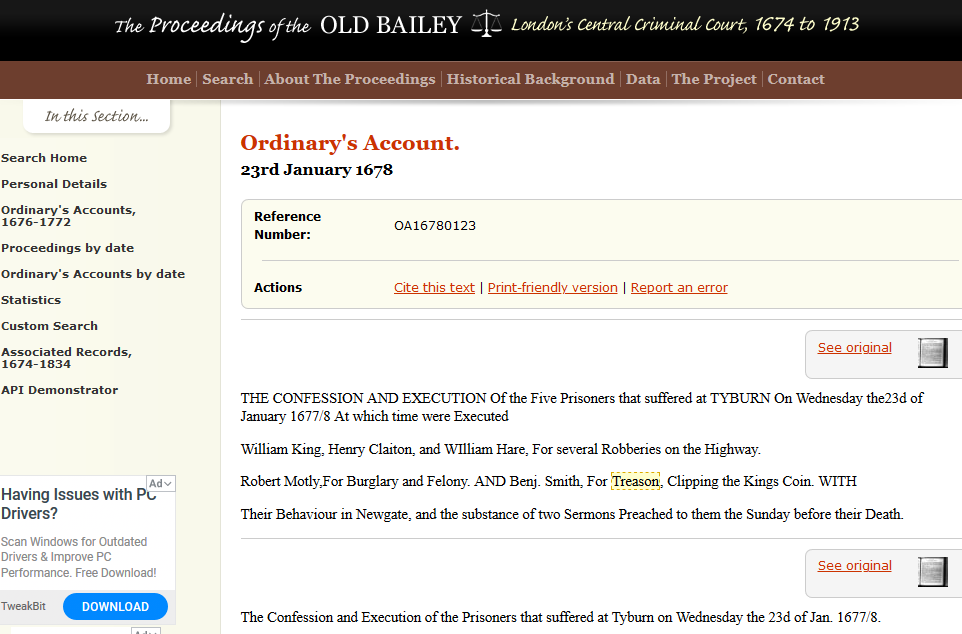
Published on 22 March 2020
I count myself very lucky in the current difficulties for many things, including having an Open University MA in English local history to be getting on with. It is 100% remote and can be done on a social-distance or self-isolation basis, apart from missing out on visiting fusty archives.
The current module is about crime and penal policy, and starts with the examination of the archive of Old Bailey proceedings. I read the transcript of the trial of Dr Crippen this morning: as a script for “Silent Witness” it would have been dismissed as fantastical.
The Old Bailey site contains the “Ordinary’s Accounts” – the reports by a chaplain on all those that suffered the death penalty between 1676 and 1772, including a brief resume of the accused and of their crime.
Benjamin Smith was hung at the Tyburn on 23rd January 1678 for high treason – betrayal of the King or conspiring to overthrow him. One manifestation of conspiracy-to-overthrow was a form of economic crime: undermining the king’s money.
Specifically Smith was convicted of “coin clipping”: shaving slivers off gold or silver coins, whose value was determined by their weight. The accused passed the coins as if they carried full value when they did not. The coins so interfered with were thereby rendered counterfeit by dint of their diminution. The slivers were melted, re-cast and sold on, for chains, watches or whatever – a form of theft. But the main concern of the authorities was the counterfeting-by-diminution: a coin issued with a value of 1oz of gold turned out to be worth only 98% of its intrinsic value.
This raises an interesting theme around any form of crypto-currency, which is not legal tender, and has not been issued – and is not backed – by a central bank acting in the name of the head of state (our current Queen Elizabeth II as opposed to Charles II in 1678) with the full faith and credit of a nation.
Naked crypto-currency has zero intrinsic value, whereas stablecoin claims to be backed by a fiat currency or by gold, silver or whatever, less costs. These costs can be likened unto the slivers shaved off the coins-of-the-realm in the seventeenth century, rendering stablecoin as a diminished version of the real fiat currency, or of the gold, the silver or whatever backs it.
On that basis promoters of a stablecoin can be classed as 21st century coin clippers, and should arguably face the full force of 17th century justice.
It may seem unfair that they should go to the gallows for diminishing real currency, while those who issued naked crypto-currency – backed by fresh air – might face no worse charge than fraud, or possibly “uttering”: possessing counterfeit money or putting it in into circulation. More on that in a further post.
According to the Ordinary, those convicted of “coin clipping” might suffer an intermediate fate between normal hanging (standing under the gibbet on a cart which was then pulled away) and the traditional despatch for treason of being transported to the Tyburn tied to a wicket, there to be hung, drawn and quartered: coin-clippers got the wicket and the hanging, but missed out on the drawing and quartering. That must have been of some comfort.
